It’s easy to make your own concrete hypertufa planters…
My friend Cheryl and I had each heard about hypertufa container projects and been fascinated, but both had put it off for years as a ‘someday’ project. This would change today! Here’s the story of our first try…
What are hypertufa troughs?
Hypertufa (pronounced hyper-toofa) is a mixture of peat moss, perlite, cement and water and were invented by alpine plant enthusiasts as perfect replacements for the old stone trough planters so desired so show off their tiny plants. Old stone watering troughs in England could be found in farmer’s fields, sometimes built into stone walls to provide water for two fields of livestock.
These troughs are usually one-of-a-kind, and very rare and desirable to alpine gardeners and plant collectors and are very expensive and heavy, as well. They’re fabulous for succulents because the rustic texture of the containers contrast with the fine intricate shapes of tiny groups of hens and chicks and other succulents.
There is a natural volcanic rock called tufa, which has also been used by gardeners. However, there are few natural deposits found around the world, some in Britain, some in North America and various other areas which makes trough made from this material rare and valuable. In the 1800’s, English gardeners found that by mixing certain ingredients they could make a light weight version of stone troughs. In time, hypertufa will develop the look of weathered stone.
For those who like miniature plants which often get lost in a garden, making your own troughs, and really, any shaped stone-like container, is easy and fun! I like growing succulents and other small plants and after hearing about hypertufa long, long ago, have always wanted to try it.
So,… this past month my friend Cheryl and I decided to give ourselves an assignment: to give a workshop to our garden club! O…K…!
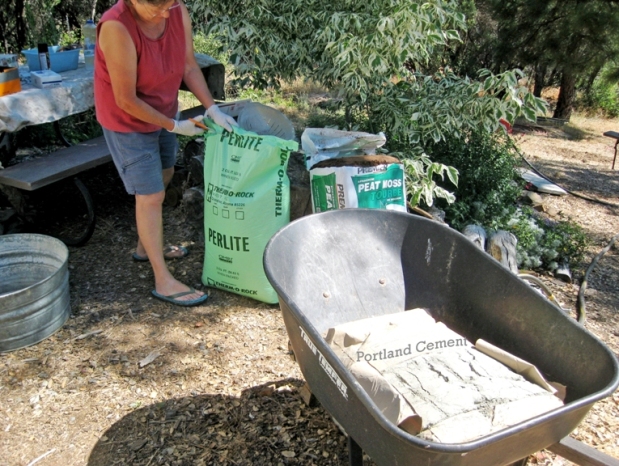
Cheryl measures out dry ingredients in a galvanized container. Mix cement, peat & perlite before adding the water.
We used a 1 quart measure. 4 scoops of each, cement, peat moss and perlite. That made two small troughs. We made two batches and four troughs in three hours. The first hour was running around finding equipment and setting up.
Finding the Materials for hypertufa projects
It was a bit daunting just to buy the materials. The peat moss was easy, available in big bales at our local hardware store. The Portland cement, only available in 93 lb bags at the lumber store was never touched by me until Tractor Man hefted it down the steps to our old picnic table work area. the big bag of perlite was only available at a big box store and was picked up next time we went to to the valley. everything else we scrambled for the day before our project.
The mix is not sticky and it’s easy to clean up. Surprised me!
We prepared the molds, plastic containers, or corrugated boxes, lining each with a dry cleaning bag. Add water to the mix a little at a time until it feels like mud pies, or Brownie batter and holds together in a ball when you squeeze it.
Hpertufa making Supplies
- mixing tub
- container for measuring
- peat moss
- perlite
- Portland cement
- dust mask
- rubber gloves
- trowel
- plastic or canvas drop cloth
- container for a mold
- Dry cleaning bags
- *Optional
Hardware cloth or wire screen ‘sifter’ for the peat
The sides are 1 1/2” thick. While we did this one, we had two other molds ready and waiting.
Press firmly and don’t jostle the box or the trough will crumble. DON’T use shoe boxes like we did with this one. The corrugated shown above is better. We wrapped the shoebox with duct tape and it still wobbled out of shape. The bottom will be square and the top round, but Cheryl said she liked it that way.
Carefully lift box or container into a plastic trash bag, mist with water and seal loosely. For one day leave the trough in the bag and mist a couple times so it dries slowly. Do not move or they will crumble.
IMPORTANT: The next day, take out the sticks used to make drain holes. It’s much harder to do so afterward.
After a week, I cut away the box molds and carefully let them dry further without the plastic bags.
Hypertufa Recipe
- 1 part Portland cement
- 1 part sphagnum peat moss
- 1 part perlite ….easy, right?
Five Steps
- Mix Ingredients with water
- Mold the trough
- Wrap in plastic
- Unmold and cure
- Soak to leach out lime
Day Two- Unmolding and mixing the second batch
This day, we planned to un-mold the troughs we made, make another batch with a slightly different mix and plant some as examples to show at our demonstration in two days.
We had used dry cleaning bags to line the plastic containers, so when un-molding, just gathered up the corners and lifted the trough right out. They were fragile.
We carefully soaked the troughs in a wheelbarrow full of water for three days before planting to leach out the lime from the cement. Guess plants don’t like too much lime. Note…we skipped this step for any other troughs. You can do it, or not,…we planted our un-soaked troughs and they do fine.
One added tip: After storing the bale of peat moss for a few weeks,..it get dry, hard and hard to shred into fine pieces to mix with the other ingredients, but,….if the day before you wet it down thoroughly, it’s much easier to work with. After a few times,…I’d just stick the hose into the bag and soak the whole thing, adding about a gallon of water. The next day, it’s moist and crumbly, the perfect texture to work with.
Planting your new hypertufa troughs
Then came the fun part,…planting which we did the next week. While planting we moved the troughs by sliding them on the cardboard. We decided to use succulents, but think miniature bulbs would look great in these!
Thanks for viewing our fun experience! Try it and comment if you do. Or Pin it for later….

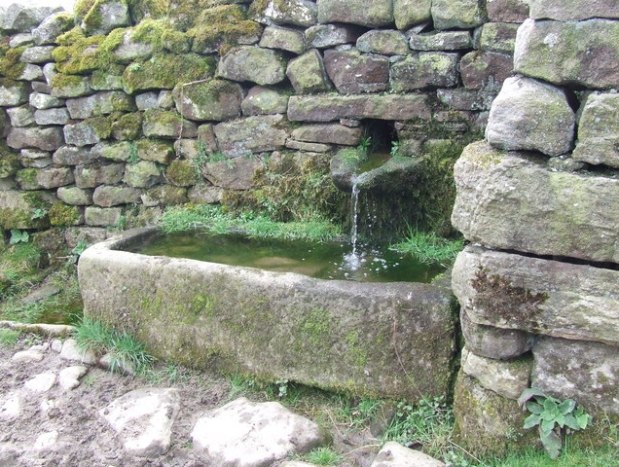
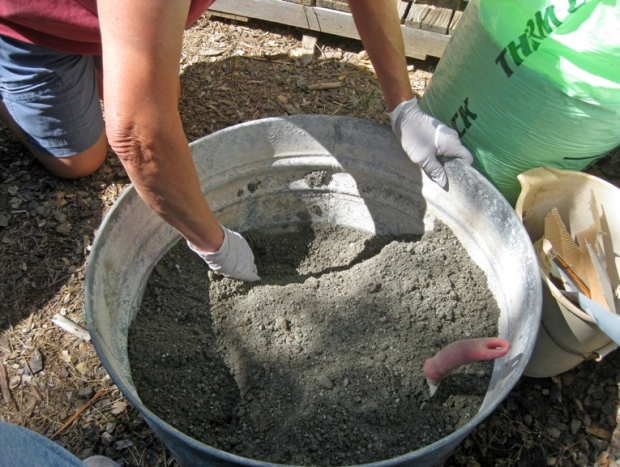
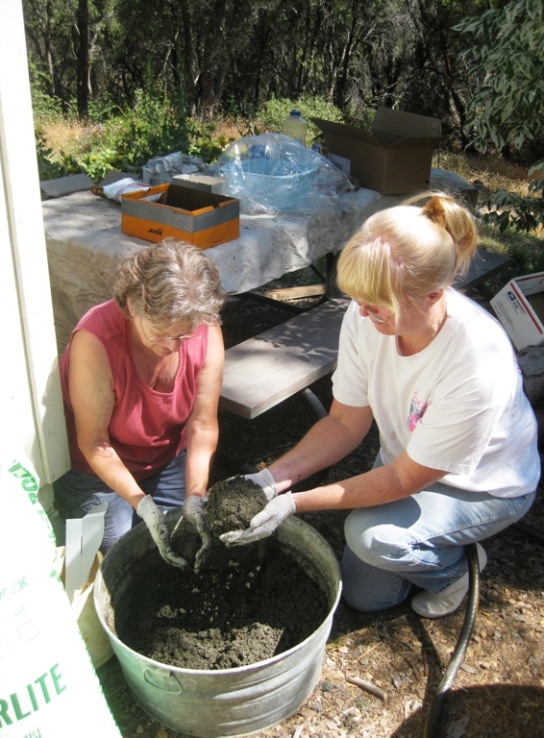
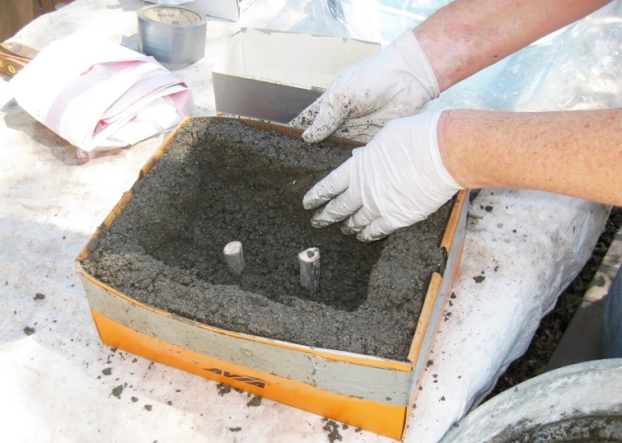
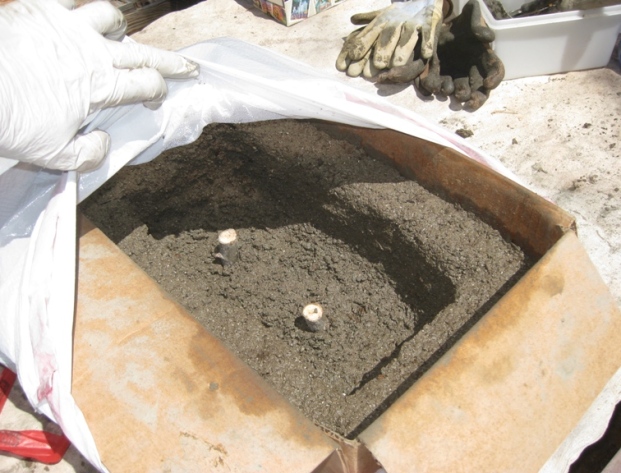
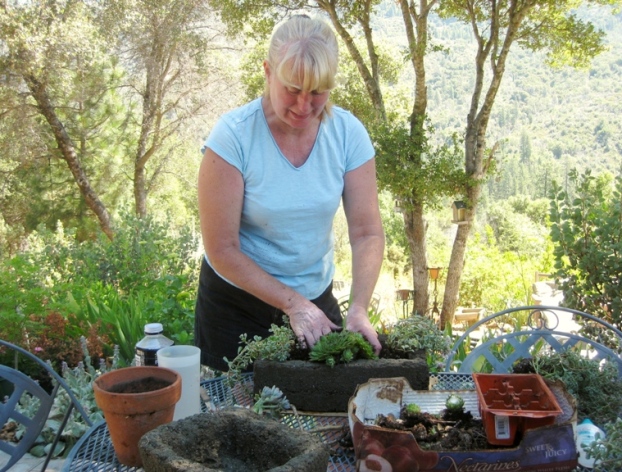
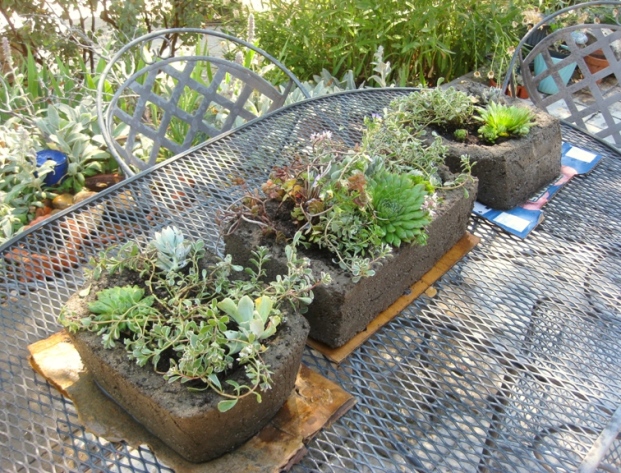




9 Comments
You girls did a great job, the planters are awesome. I wonder if you could lay down fern leaves, or something along those lines in the container before you pour the mix in and if they would leave an imprint on the outside of the planter? Maybe something heavier such as a plastic fern leaf? What do you think?
Oooh, Edie, that’s a great idea that we hadn’t thought of. We’ve done leaf castings before, but haven’t combined the two techniques like you describe. I’d love to try that! ~~ Sue
Sounds great but please use straw or hay rather than peat moss which is an endangered species in many parts of the world. At the rate it is being harvested it just isnt renewable.
thanks for the info about peat moss. we have cows and plenty of old hay
On my ‘to-do’ list w/a friend! TFS the pics & great instructions, Sue!
I’ve seen quite a few blogs on this but this one IS PERFECT. Easy to read and understand for newbies at it like myself. I recall reading somewhere its important to water not only your plant but also your planters to prevent it from drying out and crumbling. #1. Have you all had this problem? #2. Have you noticed the planters expanding or shrinking? (I’ve not read this anywhere,just curious ?)#3. On removing the lime by soaking,#4. Last question,what is the biggest planter you guys have made successfully? (((((I AM REALLY WANTING TO MAKE ONE GALVANIZED CONTAINER SIZE JUST LIKE THE ONE YOU USED TO PUT YOUR INGREDIENTS INTO USED IN THIS POST))))))
Thank you,I really look forward to your response!
Robin
I am looking to make a big container- like the size of the galvanized tub you used to mix. And i want to use it indoors. Any tips?
Hi Marie!
Yes, I have a few tips. Make the ‘walls’ of your ‘tub’ a little thicker than normal,…maybe 2″ to 2 1/2″ thick. Dry it for two days instead of one and get someone to help you un-mold it. If you want to use it indoors, you con consider not making a drain hole to make it watertight. Also you might insert small wooden ‘feet’ to hold it off the surface of the floor or setting it on some kind of protective mat. If it won’t be moved often, you can use wine corks.
Best wishes and do post a photo on our FB page when you finish. What a neat project!
hi i enjoy what i see and learning alot.i want to do my own garden plant bowls and want to ask if you can send me the resipe to mix for these bowls i would truly appreciate it kind regards Kathy Swart